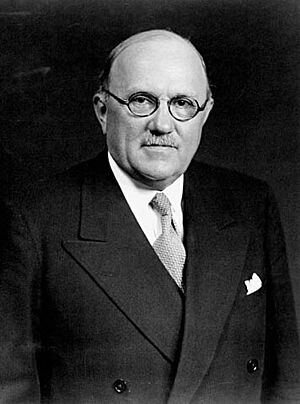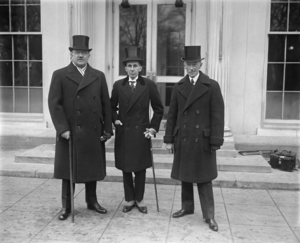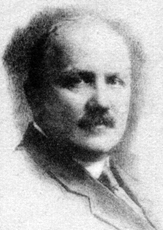Ernest Lapointe facts for kids
Quick facts for kids
Ernest Lapointe
|
|
|---|---|
 |
|
| Minister of Justice Attorney General of Canada |
|
| In office October 23, 1935 – November 26, 1941 |
|
| Prime Minister | W. L. Mackenzie King |
| Preceded by | George Reginald Geary |
| Succeeded by | Joseph-Enoil Michaud (acting) |
| In office September 25, 1926 – August 6, 1930 |
|
| Prime Minister | W. L. Mackenzie King |
| Preceded by | Esioff-Léon Patenaude |
| Succeeded by | Hugh Guthrie |
| In office January 30, 1924 – June 28, 1926 Acting: January 4, 1924 – January 29, 1924 |
|
| Prime Minister | W. L. Mackenzie King |
| Preceded by | Lomer Gouin |
| Succeeded by | Hugh Guthrie (acting) |
| Secretary of State of Canada | |
| In office March 24, 1926 – June 28, 1926 (acting) |
|
| Prime Minister | W. L. Mackenzie King |
| Preceded by | Charles Murphy (Acting) |
| Succeeded by | George Halsey Perley |
| In office July 26, 1939 – May 8, 1940 (acting) |
|
| Prime Minister | W. L. Mackenzie King |
| Preceded by | Fernand Rinfret |
| Succeeded by | Pierre-François Casgrain |
| Member of Parliament for Quebec East |
|
| In office October 27, 1919 – November 26, 1941 |
|
| Preceded by | Wilfrid Laurier |
| Succeeded by | Louis St. Laurent |
| Member of Parliament for Kamouraska |
|
| In office February 12, 1904 – October 14, 1919 |
|
| Preceded by | Henry George Carroll |
| Succeeded by | Charles-Adolphe Stein |
| Personal details | |
| Born | October 6, 1876 Saint-Éloi, Quebec, Canada |
| Died | November 26, 1941 (aged 65) |
| Political party | Liberal |
| Spouse |
Emma Pratte
(m. 1904) |
| Relations | Arthur-Joseph Lapointe (nephew) |
| Children | Hugues Lapointe |
| Alma mater | Laval University |
| Occupation | Lawyer |
Ernest Lapointe (born October 6, 1876 – died November 26, 1941) was an important Canadian lawyer and politician. He was a Member of Parliament from Quebec. He also served as a senior minister for Prime Minister W. L. Mackenzie King. Lapointe played a big role in legal matters and in representing French-speaking Canadians.
Contents
Becoming a Lawyer
Ernest Lapointe studied law at Laval University. He became a lawyer in 1898. He worked as a lawyer in Rivière-du-Loup and Quebec City.
Starting in Politics
Lapointe first became a Member of Parliament (MP) in 1904. He was elected without anyone running against him in the area of Kamouraska. He was a member of the Liberal Party.
He was re-elected several times in the years that followed. In 1919, he changed the area he represented. He won the election for the Quebec East area. This seat had been left empty by former Prime Minister Wilfrid Laurier after he passed away.
Working with Prime Minister King

In 1921, Prime Minister William Lyon Mackenzie King chose Lapointe to be part of his group of ministers, called the Cabinet. Lapointe first became the Minister of Marine and Fisheries. During this time, he helped lower taxes on imported goods.
In 1924, Lapointe became the Minister of Justice. He held this job until the Liberal Party lost the election in 1930. When the Liberals won again in 1935, Lapointe became Minister of Justice once more.
Supporting Canadian Independence
As Minister of Justice, Lapointe strongly supported Prime Minister King's goal for Canada to be more independent. He went with King to an important meeting called the Imperial Conference of 1926. Lapointe also led the Canadian team in talks that led to the Statute of Westminster in 1931. This law made Canada and other countries more independent from the United Kingdom.
Voice for Quebec
Lapointe was a very important minister in King's Cabinet. He was known as King's "Quebec lieutenant." This meant he was the main person King relied on for important matters in Quebec. Prime Minister King did not speak French well, so Lapointe's role was crucial. Lapointe made sure that the voices and concerns of French-speaking Quebecers were heard in the government's decisions. This was very important, as it had not been the case for some time.
In the late 1930s, Lapointe suggested that the federal government should stop some laws passed by the Alberta government. He believed these laws tried to take too much power and interfered with federal responsibilities.
However, Lapointe did not suggest stopping the "Padlock Act" in Quebec. He was worried that doing so would only make the Quebec government more popular.
Dealing with Conscription
Lapointe played a key role in creating Prime Minister King's policy against conscription for overseas military service in 1939. Conscription meant forcing people to join the army. Lapointe worked hard to prevent this, especially for French Canadians.
During the 1939 Quebec election, Lapointe gave many speeches. He warned that if the Quebec government was re-elected, all French-Canadian ministers would leave the federal Cabinet. This would leave French-speaking Canadians without a voice in the federal government. Lapointe remembered how much the conscription crisis of 1917 had divided Canada. He wanted to protect the national unity that King had worked to build. The Quebec government lost the election, and a new leader who wanted to work with the federal government was elected.
Later Life and Legacy
Ernest Lapointe passed away in 1941 while still serving as Minister of Justice during World War II. After his death, Prime Minister King appointed Louis St. Laurent as the new Minister of Justice.
Lapointe's son, Hugues Lapointe, also became a Member of Parliament. He later served as the Lieutenant Governor of Quebec.
Images for kids
See also
- Conscription Crisis of 1944



